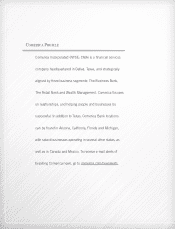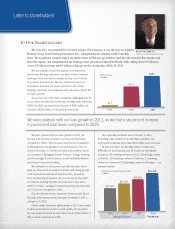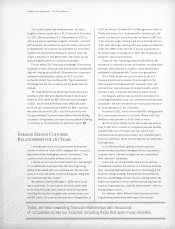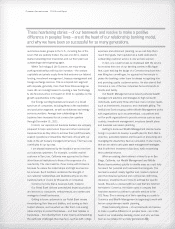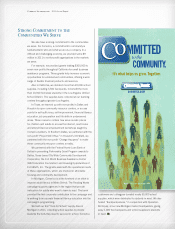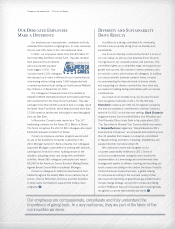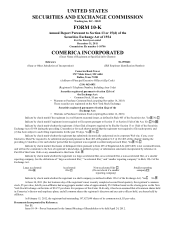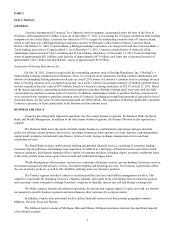Comerica 2011 Annual Report Download - page 12
Download and view the complete annual report
Please find page 12 of the 2011 Comerica annual report below. You can navigate through the pages in the report by either clicking on the pages listed below, or by using the keyword search tool below to find specific information within the annual report.2
The Western market consists of the states of California, Arizona, Nevada, Colorado and Washington. California
operations represent the significant majority of the Western market.
The Texas and Florida markets consist of the states of Texas and Florida, respectively.
In addition to the four primary geographic markets, Comerica also considers Other Markets and International as
market segments. Other Markets include businesses with a national perspective, Comerica’s investment management and trust
alliance businesses as well as activities in all other markets in which Comerica has operations, except for the International
market. The International market represents the activities of Comerica’s international finance division, which provides banking
services primarily to foreign-owned, North American-based companies and secondarily to international operations of North
American-based companies.
We provide financial information for our segments and information about our non-U.S. revenues and long-lived
assets: (1) under the caption, “Strategic Lines of Business” on pages F-13 through F-16 of the Financial Section of this report;
and (2) in Note 23 of the Notes to Consolidated Financial Statements located on pages F-111 through F-115 of the Financial
Section of this report.
We provide information about the net interest income and noninterest income we received from our various classes of
products and services: (1) under the caption, “Analysis of Net Interest Income—Fully Taxable Equivalent (FTE)” on page F-6
of the Financial Section of this report; (2) under the caption “Net Interest Income” on pages F-7 through F-8 of the Financial
Section of this report; and (3) under the caption “Noninterest Income” on pages F-9 through F-10 of the Financial Section of
this report.
We provide information on risks attendant to foreign operations: (1) under the caption, “Provision for Credit Losses”
on pages F-8 through F-9 of the Financial Section of this report; (2) under the caption “Market Segments” on page F-14
through F-16 of the Financial Section of this report; (3) under the caption “Concentration of Credit Risk” on page F-31 of the
Financial Section of this report; and (4) under the caption "International Exposure" on pages F-35 through F-36 of the Financial
Section of this report.
COMPETITION
The financial services business is highly competitive. Comerica and its subsidiaries compete primarily with banks and
other financial institutions for various deposits, loans, trust services and/or other products and services in their primary
geographic markets of Texas, Arizona, California, Florida and Michigan; through their other offices in Colorado, Delaware,
Illinois, Massachusetts, Minnesota, New Jersey, Nevada, New York, North Carolina, Ohio, Tennessee, Virginia, Washington,
Canada and Mexico; and in selected other U.S. markets as opportunities arise.
Comerica believes that the level of competition in all geographic markets will continue to increase in the future. In
addition to banks, Comerica’s banking subsidiaries also face competition from other financial intermediaries, including savings
and loan associations, consumer finance companies, leasing companies, venture capital funds, credit unions, investment banks,
insurance companies and securities firms. Competition among providers of financial products and services continues to
increase, with consumers having the opportunity to select from a growing variety of traditional and nontraditional alternatives.
The industry continues to consolidate, which affects competition by eliminating some regional and local institutions, while
strengthening the franchises of acquirers.
SUPERVISION AND REGULATION
Banks, bank holding companies and financial institutions are highly regulated at both the state and federal level.
Comerica is subject to supervision and regulation at the federal level by the Board of Governors of the Federal Reserve System
(“FRB”) under the Bank Holding Company Act of 1956, as amended. The Gramm-Leach-Bliley Act expanded the activities in
which a bank holding company registered as a financial holding company can engage. The conditions to be a financial holding
company include, among others, the requirement that each depository institution subsidiary of the holding company be well
capitalized and well managed. Effective July 2011, the Dodd-Frank Wall Street Reform and Consumer Protection Act (the
“Financial Reform Act”) also requires the well capitalized and well managed standards to be met at the financial holding
company level. Comerica became a financial holding company in 2000. As a financial holding company, Comerica may
affiliate with securities firms and insurance companies and engage in activities that are financial in nature. Activities that are
“financial in nature” include, but are not limited to: securities underwriting; securities dealing and market making; sponsoring
mutual funds and investment companies (subject to the prohibitions of the Volcker Rule, described below); insurance
underwriting and agency; merchant banking; travel agent services; and activities that the FRB has determined to be financial in
nature or incidental or complementary to a financial activity, provided that it does not pose a substantial risk to the safety or


